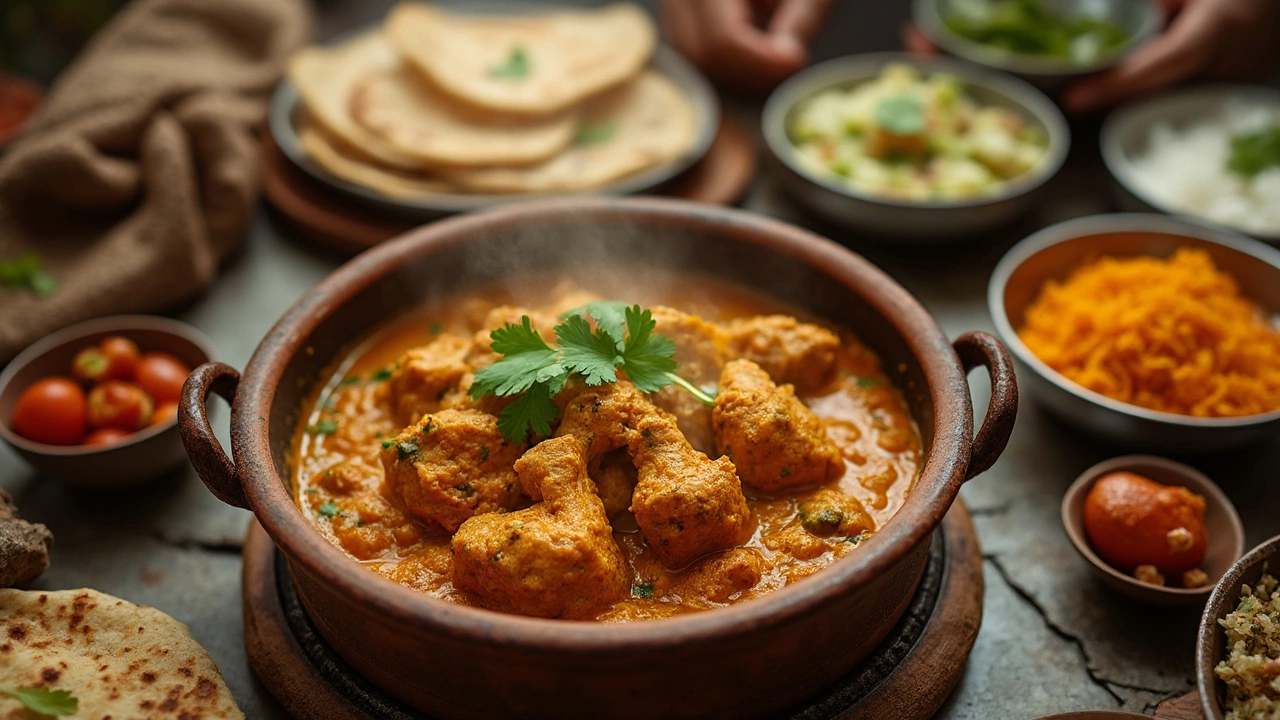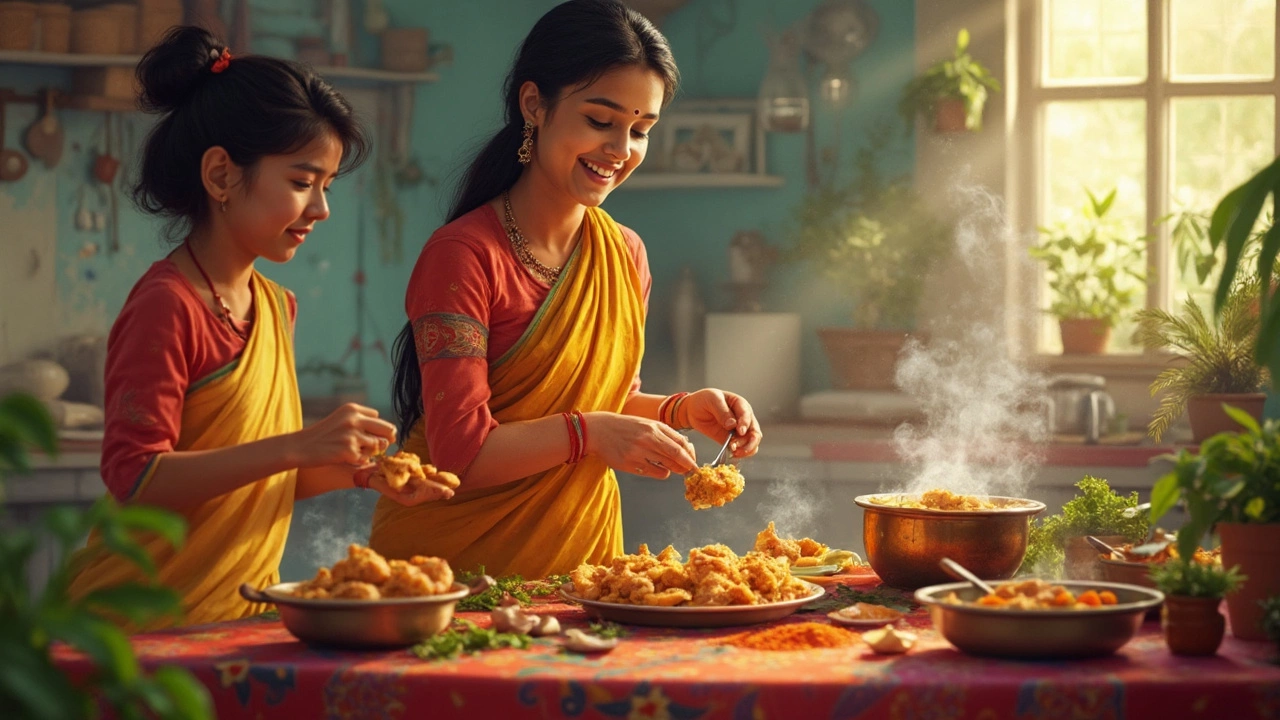Walk into any Indian home during Sunday lunch and there’s a good chance you’ll smell chicken curry bubbling away in the kitchen. It’s not just a family favorite—across both big cities and small towns, classic chicken curry rules the Indian menu. There are flashier dishes out there, but nothing touches chicken curry’s hold on people who want something comforting, affordable, and packed with flavor.
Chicken curry is also insanely flexible. Whether you like it spicy, creamy, or lip-smackingly tangy, this dish molds itself to local tastes and the cook’s mood. That’s a big reason why it wins the popularity contest. You’ll see it at wedding buffets, get-togethers, and even tiffin boxes. And when there's a festival or a lazy day at home, it’s often chicken curry that ends up on the table.
- Why Chicken Curry Is the King
- Secret Ingredients That Make All the Difference
- Chicken Curry Across the States
- Tips for Making Perfect Chicken Curry at Home
Why Chicken Curry Is the King
So, what makes chicken curry such a superstar in India? It starts with one simple thing: everyone eats chicken. From north to south, east to west, chicken is eaten by people from nearly every religion and background. It dodges food restrictions, unlike beef and pork, and it's more wallet-friendly than fish or mutton for most families.
Ask any street food vendor or home cook, and they'll tell you chicken curry is the no-brainer crowd-pleaser. It’s filling, quick enough for busy days, and easy to jazz up when guests drop by. The ingredients aren’t anything fancy either—most basic versions need just onions, tomatoes, basic spices, and chicken. It fits comfort food cravings, but you can still make it look special with a splash of cream or fresh coriander.
It doesn’t hurt that chicken cooks faster than red meat. This means getting dinner on the table in under an hour is totally do-able, which matters when everyone’s hungry. There are even entire restaurants, like Daryaganj in Delhi, built around classic chicken curry and similar dishes. One food historian, Pushpesh Pant, summed up its influence perfectly:
"If you want to understand India’s food heart, look at chicken curry. It’s what families make at home, what’s ordered most at restaurants, and the dish offered to guests with pride."
Another big reason for its crown? It adapts everywhere. Home cooks in Punjab will add ghee and garam masala, while someone in Kerala might reach for coconut and curry leaves. So whatever you grew up with, there’s a chicken curry version close to your heart.
Secret Ingredients That Make All the Difference
Everyone has their spin on chicken curry, but true flavor bombs come down to a handful of smart choices. These small ingredients and steps make the biggest change to your final dish. If you've tried a chicken curry at a friend’s place and wondered why it tasted so much better—this is probably why.
- Onions, But Not Just Chopped: The most flavor comes from slow-cooked onions, brown and almost sticky. Rushing this step means missing out on that rich, caramel background.
- Ginger-Garlic Paste: Don't skip fresh paste. Pre-made bottled stuff works in a pinch, but a quick homemade mix gives a deeper aroma and taste.
- Garam Masala at the End: Instead of adding all your spices up front, save a bit of garam masala for the last two minutes. The fragrance really pops and makes it taste restaurant-grade.
- Cream & Yogurt: North Indian recipes use yogurt or cream for that smooth, slightly tangy gravy. If you're in South India, coconut milk steps in for creamy vibes.
- Kasuri Methi (Dried Fenugreek): The secret chef’s ingredient—a pinch right at the end gives a nutty, herby kick.
- Curry Leaves: Especially down south, fresh curry leaves add a punch you just can’t fake with dried.
Want numbers? Here’s a quick look at how often home cooks use these secret additions, based on a 2023 survey by a leading Indian recipe platform:
| Ingredient | % of Home Cooks Using |
|---|---|
| Fresh Ginger-Garlic Paste | 86% |
| Slow-Cooked Onions | 74% |
| Cream or Yogurt | 58% |
| Kasuri Methi | 41% |
| Curry Leaves | 32% |
Each region has its thing, but even at home, these little tweaks switch up the game. Next time you cook, try upping your onion game or sprinkling that kasuri methi. You’ll taste the difference before you even finish plating up your curry.

Chicken Curry Across the States
Travel across India and you’ll notice that no two chicken curries taste exactly the same. People use whatever’s fresh and local, so you get a crazy variety depending on where you are. But no matter what, the chicken curry always hits the spot—just with a twist unique to that region.
In Punjab, chicken curry means a bold, onion-heavy sauce with lots of ginger and chunky pieces of chicken. Here, it’s often paired with naan or rice, and the gravy is usually thick. Down south in Kerala, you’ll spot green chilies, coconut milk, and curry leaves in the pot—this gives it a richer, silkier base and a freshness you won’t get elsewhere. Tamil Nadu’s version leans heavily on black pepper for that unmistakable punch.
Hop over to West Bengal, and the chicken curry (or “murgir jhol”) takes on a lighter, more watery consistency with potatoes swimming in the mix. The spices here are simpler, but mustard oil gives it a sharp kick that stands out. Meanwhile, Goan chicken curry mixes coconut and tangy tamarind, blending Indian flavors with touches from Portuguese influence.
Even within the same state, you’ll see families clinging to their own secret mix of spices or grandma’s “one thing you just have to do” trick. There’s no single “right” way, and honestly, that's the charm. Every version has fans, and almost everyone thinks theirs is the best you’ll ever taste.
If you’re curious to experiment, try these tweaks at home based on where the recipe comes from:
- Punjab: Stick to onions, tomatoes, and a touch of garam masala. Whole spices make a world of difference.
- Kerala: Use coconut oil, curry leaves, and finish with coconut milk for creaminess.
- Bengal: Add potatoes and a splash of mustard oil right at the start.
- Goa: Don’t skip the coconut and tamarind. If you like it spicy, let those red chilies shine.
Borrowing from the states is a fun way to make chicken curry exciting every single time you cook it. Don’t be afraid to mix and match based on what you have on hand or what flavors you’re after.
Tips for Making Perfect Chicken Curry at Home
If you want to make chicken curry that gets everyone asking for seconds, the small things make all the difference. Let’s break down some tried-and-true tips used in Indian kitchens.
- Chicken curry tastes best with bone-in chicken. Bones keep the meat juicy and the gravy rich and full of flavor. Skip boneless if you want that real homemade taste.
- Always marinate your chicken. Even 20 minutes in a mixture of yogurt, salt, ginger, and garlic makes the meat softer and helps the spices stick.
- Start by cooking onions longer than you think. The secret? Let them turn golden brown—this builds a deep, sweet base for your gravy.
- Use ripe tomatoes or fresh tomato puree for the sauce. Canned stuff works in a pinch, but fresh tomatoes give a natural tang.
- Don’t skimp on spices. Add garam masala near the end for the most aroma, and toast your whole spices at the start in hot oil to unlock their oils.
- If the gravy’s too thin, let it simmer uncovered. Want it creamier? Add a spoon of cream or some cashew paste at the end—this makes it restaurant-level rich.
- Always taste as you cook. Depending on your chili powder and your taste buds, you might want a bit more salt or a squeeze of lime before serving.
One last thing: let your curry rest for at least 15 minutes before digging in. The flavors settle and mix better, and you get a much tastier meal—worth the patience, trust me.
